When it comes to creating a welcoming environment, ideas about cafeteria furniture play an important role in shaping the overall experience. In addition to using strategic lighting, color subjects, etc., you should mostly consider choosing the right furniture. In this article, we will discover ten new ideas for cafeteria furniture that adds value to your location. Whether you are designing an existing cafe or starting a new one, these concepts will help you create the right internal crafts, eventually improve your customers and improve the experience!
Table of Contents
Cafeteria Furniture Design Ideas
1. Modular Seating
The best idea is to include modular seating that provides incredible flexibility. This allows you to easily configure the arrangements to accommodate different group sizes and events. This adaptability is important in a cafeteria setting where the number of mentor can be quite high.

2. Ergonomic Chairs
Relaxation is necessary in a cafeteria. You should choose ergonomic chairs as they are designed to provide support, encouraging the mentor to stay longer and enjoy their food. By giving priority to comfort, you can increase overall food experience.
3. Durable Materials
Cafeteria furniture will have to face heavy use, making the option of material significant. Opt for high quality finish that ensure ease of longevity and maintenance, makes the space look fresh.
4. Communal Tables
Large communal tables can create a sense of community and encourage social interaction between patrons. They create a welcome environment that is ideal for group food.

5. Compact and Stackable Furniture
If you are planning for small cafeteria, compact and stacked furniture can save space and simplify cleaning. This type of furniture is required to maximize efficiency without compromising.

6. Incorporate Technology
Integrating technology in your cafeteria can greatly increase customer experience. Modern patrons appreciate facilities such as charging stations and Wi-Fi access, which can make your location a popular place for working or studying.
7. Eco-Friendly Options
Stability is becoming increasingly important for consumers. It is being said that, you can choose environmentally friendly furniture not only appeal to the environment conscious customers, but also display your commitment to stability.
8. Varied Seating Options
You can try to include a mixture of seating styles as they can be useful to increase the versatility of cafeteria. In addition, providing various options encourages customers to find their ideal location.

9. Aesthetic Appeal
Although functionality is important, aesthetics should not be ignored. Correct furniture can increase the overall environment of your coffee shop, making it a more invited place.
10. Personalized Touches
Adding individual elements to your cafeteria can help create a unique atmosphere that reflects the personality of your installation. These touch can increase overall customer experience.
Other Aspects of Cafeteria Design
1. Kitchen Design
It is important to determine the scope of the project before designing cafeteria, whether it is for a new building or renewal. In addition to a cafeteria layout, which is adapted to foot traffic patterns, you should also keep in mind that your kitchen functions to ensure that there is a well -organized place for food preparation and it promotes quick service Is.
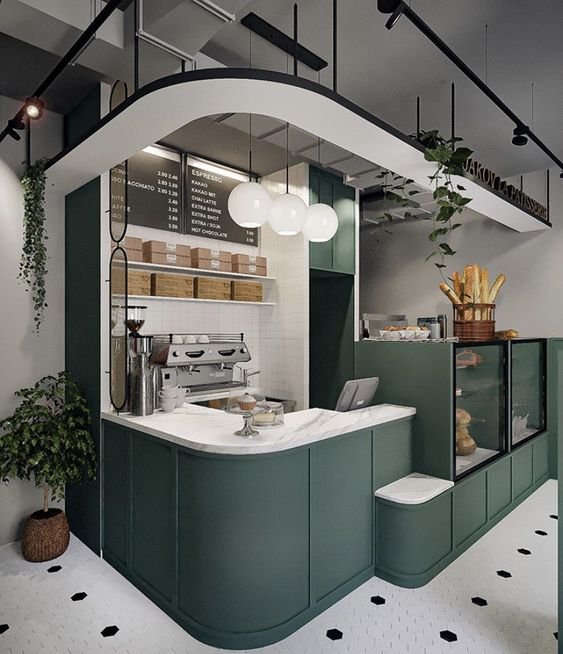
2. The Colour Scheme
The color scheme and the raw materials are two major aspects of any cafe’s interior design. Using them creatively can enhance any space in terms of look and vibe. On the other hand, choosing the wrong colors and raw materials could make your space look distasteful or – worse – boring! Before finalizing your research, do your research on which raw material you want to use in your cafe, and choose a color scheme that works well with everything else. Add a touch of modern elegance to your place with modern canvas paintings that reflect current trends. These artifacts are perfect for creating a stylish and sophisticated environment.
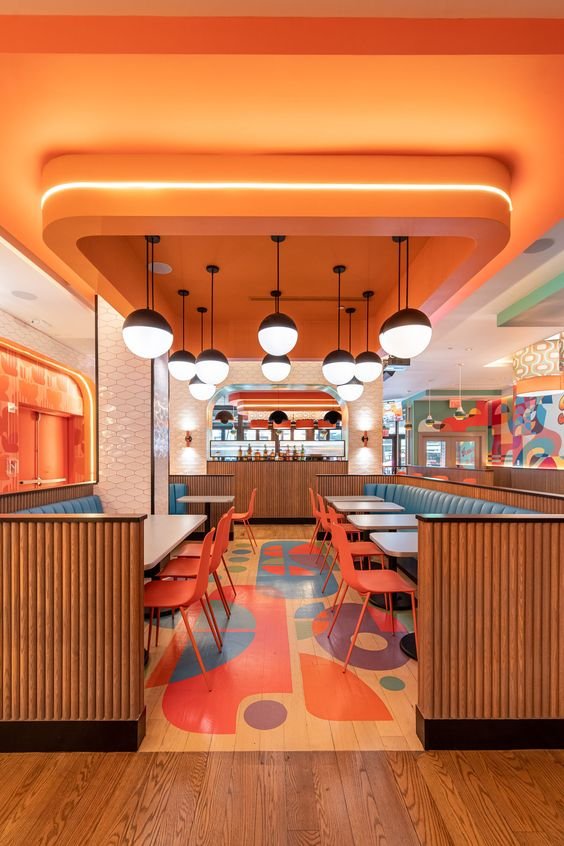
3. Modern Technology
Interactive communication and technology can be used to create a positive atmosphere in your cafeteria. Your cafeteria’s LED walls can be used for infotainment, marketing, company news, workforce updates, and art. With video content streaming services, you can also create a custom feed for visitors that correspond to your cafeteria. You can also include an AV system in your cafeteria design to showcase music, general knowledge questions, movies or presentations on your video wall.
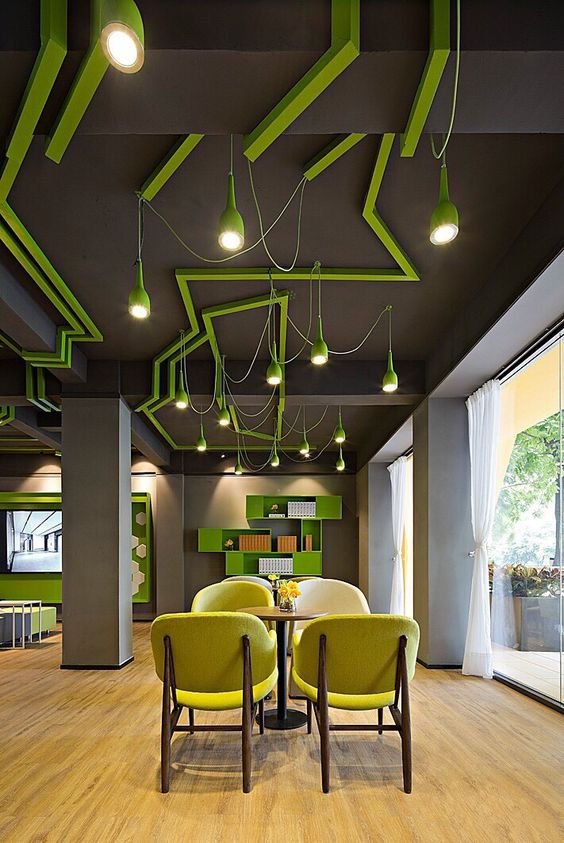
4. Ambient Lighting
The cafeteria design should be made with ample lighting. Natural lighting with an excess of light coming in from outside can be used as the primary form of lighting in the cafeteria. This will let you create more ventilated space and make the space refreshing as well. There are also ambient lights, accent lights, and decorative lights.
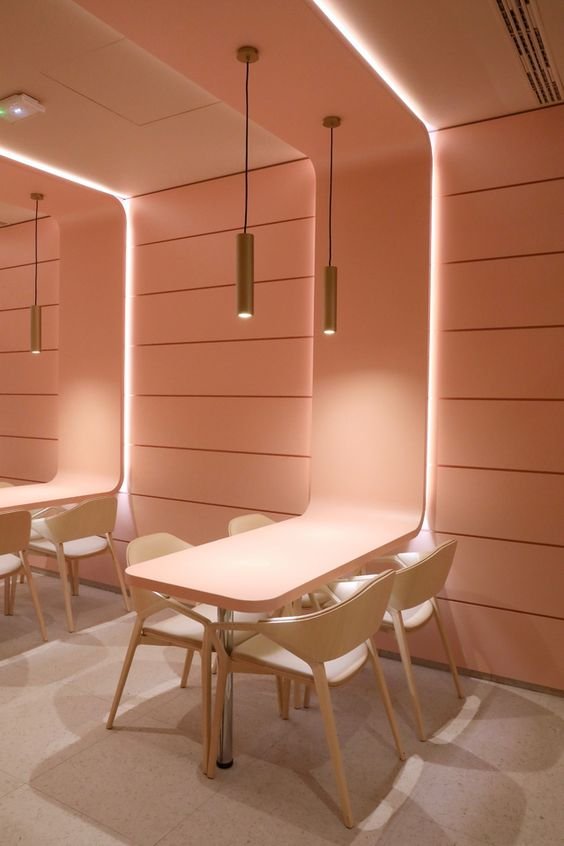
5. The Concept Of The Cafe
It is important to determine your concept before you start planning your cafeteria design. Are you going to be a friendly neighborhood cafe, a middle-value commercial cafe, a cafe near a university campus, or a high-end cafe on a posh street, what kind of coffee you will serve, and what kind of prices you Will you fee for this?
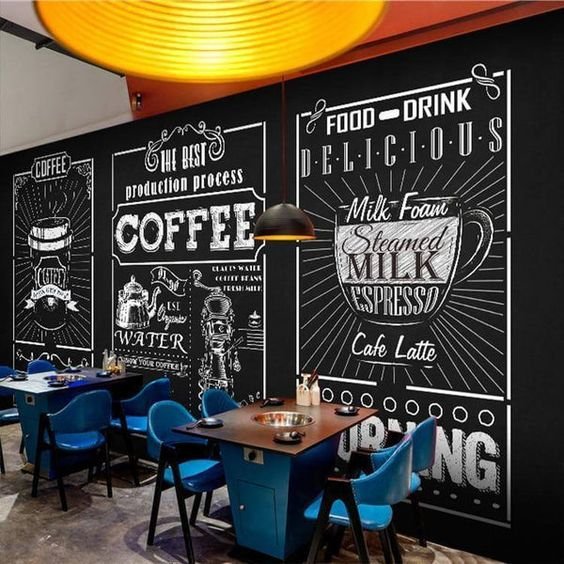
6. The Ambiance
After determining your concept, the next step is to consider the atmosphere you want to establish. It will be affected by four major factors: color, lighting, sounding and smell. Each of these elements can affect the psychology of your customers by unique ways. A successful cafeteria design takes into account how each factor will contribute to the overall environment and strive for a harmonious balance between them. The vibe of your cafe is important in making an effective interior design plan.
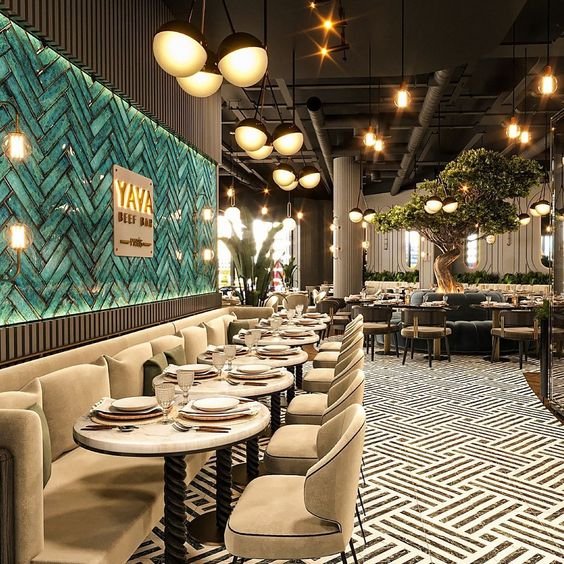
7. Acoustics
When it comes to restaurant cafe design, acoustics is one of the best contemporary restaurant interior design ideas that play an important role because sound has the ability to make us feel various emotions. Our brain reacts differently to different types of sounds. In any settings where individuals gather to eat and collect, grow and become unpleasant to noise levels. To reduce this loud discussion, it is important to include soundproofing techniques in your cafeteria design.
In addition to visual elements, consider using music as a means to change the environment of your cafe. By selecting the appropriate music, you can effortlessly establish a desirable ambiance that will attract numerous customers to your establishment. Be sure that the chosen tunes align with the color scheme and overall theme of your cafeteria design.
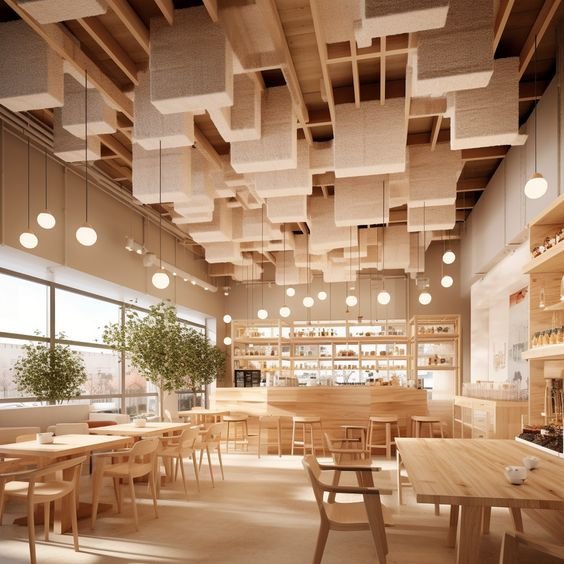
8. Scent Psychology
Different cafes will use their aroma to trigger different impulses and solve different problems. Some restaurants create a specific scent to trigger hunger in the dining area. It is not because cafes serve coffee that they leave a strong coffee-like scent in their spaces, but because they are trying to entice customers to eat more.
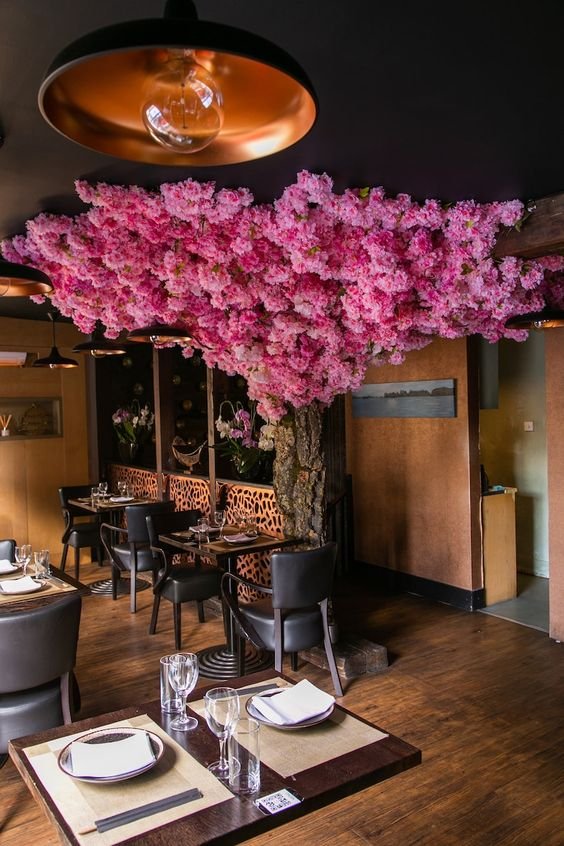
9. Designing with Natural Elements
Cafeteria Degan can be infected as greens, vertical gardens or simply potted plants with greens. It brings life into space, creates a cool and fresh environment, and helps reduce stress levels. You can also add a touch of nature to a cafeteria with stone accents and water characteristics.
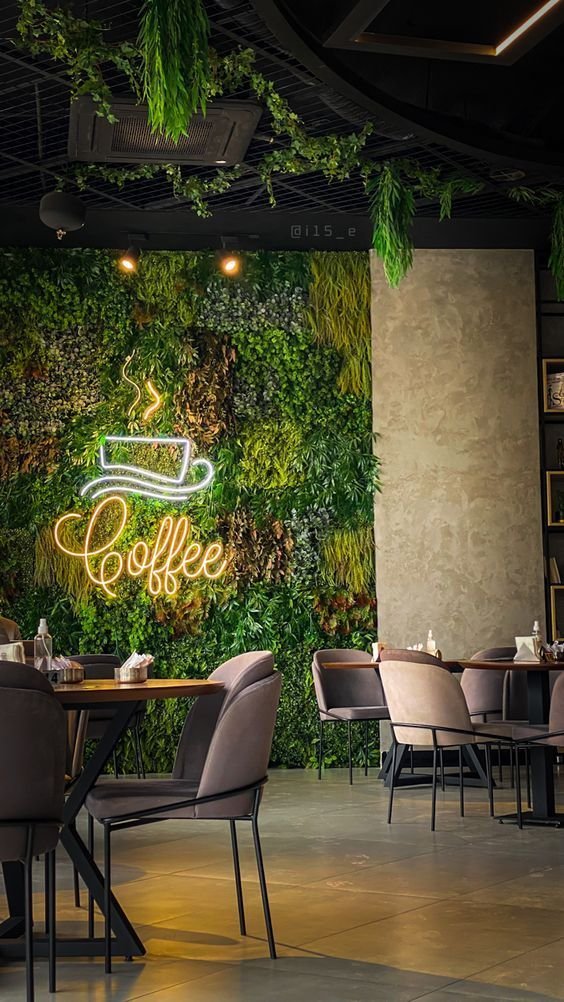
10. Privacy
Cafe fulfills both people who want to interact and those who do not. To achieve the appropriate level of privacy in a cafe, internal design elements must be placed in a way that completes both types of audiences. The appointment of furniture, the distance between the fixtures, the volume of music and the internal type of privacy to be used will be adjusted.
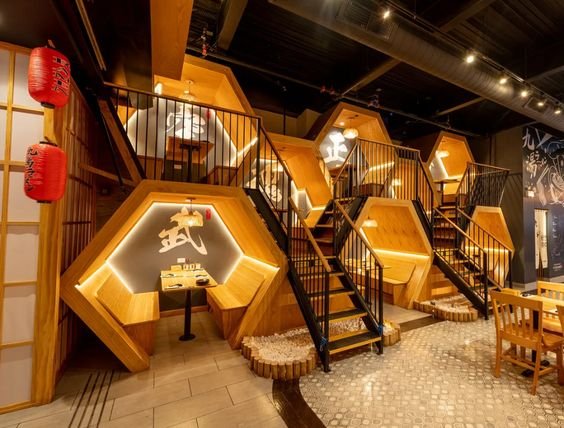
Mini Restaurant Design
Creating a successful and aesthetically pleasing design for a small restaurant depends a lot on careful planning and execution. Given the current safety rules and ideas, a small restaurant layout requires deliberate decisions to make decisions in which from out of the table, to the food distribution and the organizing of areas for service. By incorporating well -designed elements, your small restaurant can thrive as both a profitable enterprise and a popular gathering place. To help spark motivation, we have listed several ideas for small restaurant designs that you can apply.
1. Community-centred design
Communal food is one of the best elements of the interior design of a restaurant where people can come together because food is a wonderful equalizer. To create a communal atmosphere where people can enjoy and enjoy some quality time, including communal tables, TV and kid-saff equipment, have an attractive external design, and provide excellent customer service.
Interactive dining experience: Introduce interactive elements such as live cooking station or chef tables, where guests can connect with the culinary process.
Community Notice Board: Create a digital or physical community notice board where local people can post declares, events, or even recipes, promote a sense of community participation.
Seasonal Community Menu: Offer a seasonal -changing menu and expose the citrus material locally, celebrating the agricultural and culinary traditions of the community
2. Color Scheme
The dark and soil colors of a great food establishment created a feeling of intimacy and privacy, while bright colors are hungry and often used in settings where the turnover rate is valuable. Dark and earthen tones: Use dark brown, gray and greens for a comfortable, intimate food experience in Upskale settings.
Bright colors: Include vibrant hues like red, oranges, or yellows for quick food or high turnover, to stimulate hunger.
Contrasting accents: neutral tones with a splash of bold colors in decoration or decoration to create visual interest without heavy to heavy space.
Seasonal theme: Change color accents seasonally to keep the atmosphere fresh and aligned over time of the year.
3. Lighting
The best way to go to natural light is that you use your window location wisely or consider installing large windows to go in more sunlight. Natural light maximumization: Place the table near strategically large windows or install skylights to maximize natural light during day time.
Demable Fixty: Use Demble Light Fits to adjust the atmosphere for different time of day or evening.
Warm lighting: Warm, soft lighting option in dining areas to create a comfortable and invited environment.
Pronunciation light: Highlight architectural features or artwork with pronunciation lighting to add depth and interest in space.
Candlelight effects: Use candles or impure candle fixtures on tables to create a romantic or intimate food experience during the evening.
4. Compact Entrance
Design an inviting entrance that manages guest flow efficiently, ensuring a delightful dining experience. Discuss how to design a compact yet welcoming entrance.
- Efficient flow design: Apply a foger or vestibuel to manage incoming and outgoing traffic smoothly.
- Beauty Appeal: Design the entrance to reflect the internal style of the restaurant, provide preview of food experience.
5. Strategic Seating ArrangementsWe will discuss the advantages of flexible seating options including banquet, bar seating and wise space tables made of marble and granite to create a dynamic yet intimate atmosphere.
Outdoor Dining Pods: Install outdoor dining pods or individual igloo-style seating options that provide privacy and protection from elements.
Floating booths: Create a floating booth design suspended from the roof or provides a unique food experience, supported by the minimum stand.
Convertible seating: Include seating options that can change from day to night use, such as lounge chairs that convert to food seats.
Also read: restaurant decoration ideas


